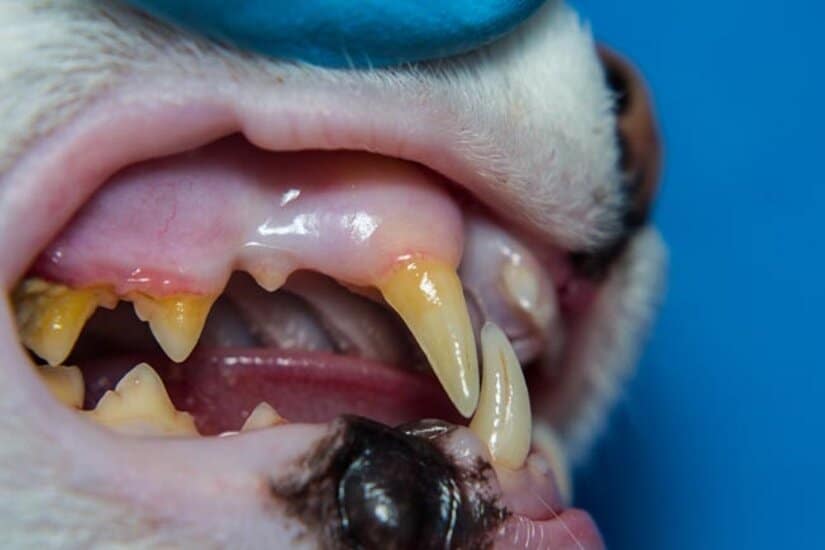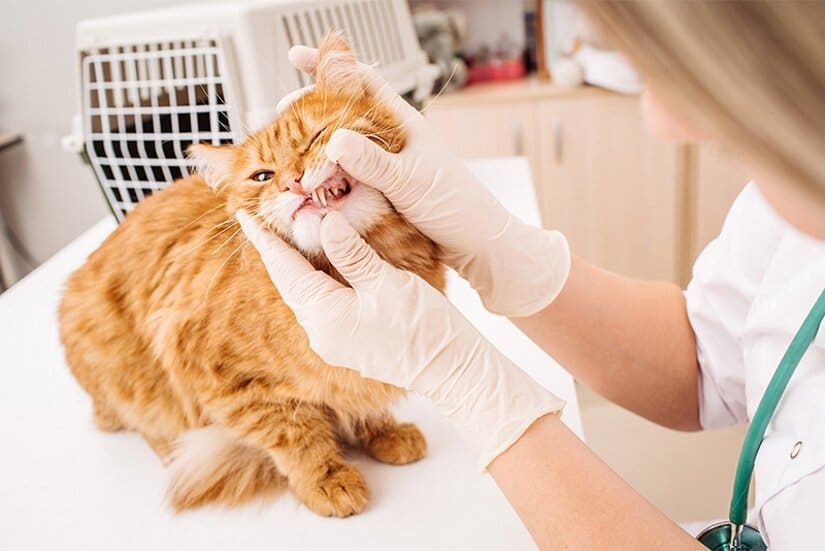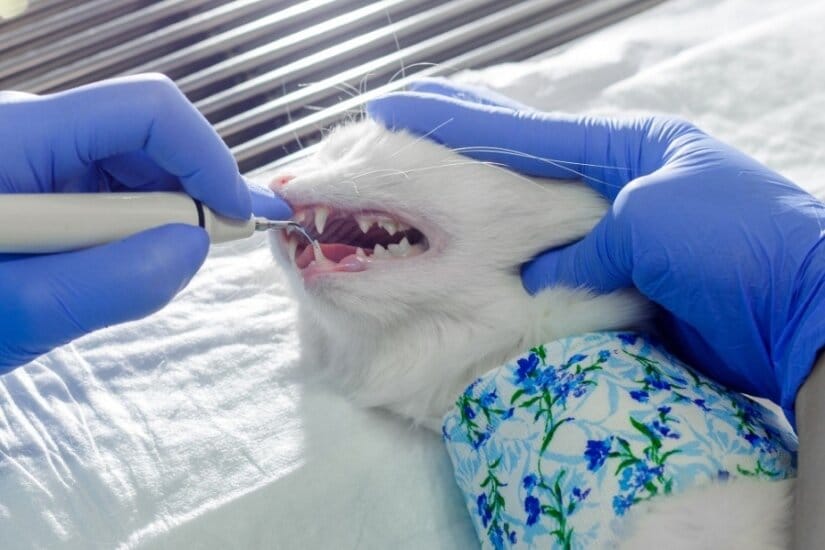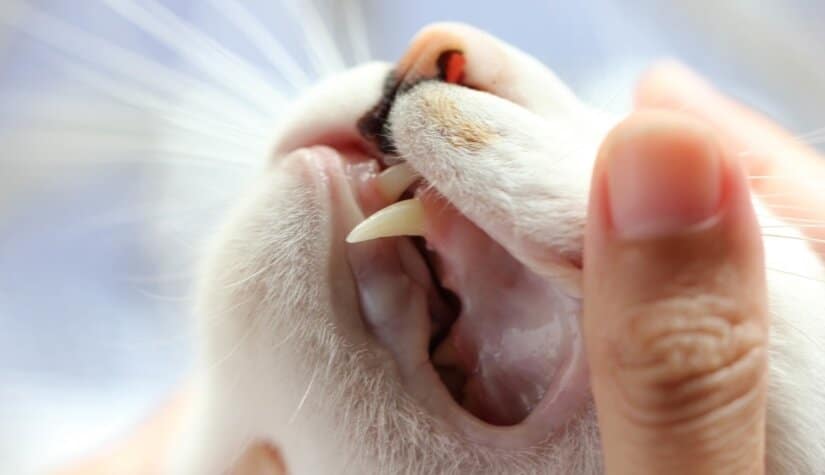Cats can become affected with many of the same dental disorders that affect humans. Treatment is also similar. The American Veterinary Medical Association (AVMA) adds that your cat’s teeth and gums should be checked at least once a year by your veterinarian to check for early signs of dental issues, and to keep your cat’s mouth healthy and free of disease. Lack of dental care is the main cause of gingivitis in cats.
Feline teeth are designed for carnivorous use, to slice and tear through food, instead of chewing it. This usually keeps teeth in good shape. The Veterinary Oral Health Council (VOHC) explains that bad breath is the most common affect noted by owners, and that this is only the tip of the iceberg.
Dental disease in pets can also lead to serious health risks. This is “because bacteria surrounding the roots gain access to the blood stream (bacteremia).” They add that “dental plaque and tartar accumulate most rapidly on the buccal (cheek) surfaces of the upper teeth of dogs and cats, and that these areas should be targeted for particular attention during regular brushing that may not include the full VOHC brushing sequence.” VOHC also explains that some brushing done regularly, is better than no brushing at all.
Cats have mouths that react intensely when faced with dental issues like gingivitis and periodontitis. The most important thing that you can do as a pet parent is to use at-home effective cat specific prevention methods to keep your cat’s teeth and gums healthy and clean.
Kittens get their deciduous premolars in between 5-6 weeks of age, and their deciduous incisors start coming out between 2-4 weeks of age. At six weeks of age, a kitten’s teeth are sharp and strong. Your cat’s permanent teeth will usually start showing up at around 4-7 months. Keep in mind that cats have 26 deciduous teeth and 30 permanent teeth with all teeth having specialized functions, depending on where they’re located in the mouth.
Changes in Behavior
“Some pets become irritable when they have dental problems, and any changes in your pet’s behavior should prompt a visit to your veterinarian. Always be careful when evaluating your pet’s mouth, because a painful animal may bite,” via AVMA. The most important thing to remember is that dental disease rarely happens around clean teeth. Here are a few signs that the AVMA recommends we to look out for:
- Bad breath
- Broken or loose teeth
- Extra teeth or retained baby teeth
- Teeth that are discolored or covered in tartar
- Abnormal chewing, drooling, or dropping food from the mouth
- Reduced appetite or refusal to eat
- Pain in or around the mouth
- Bleeding from the mouth
- Swelling in the areas surrounding the mouth
- Drooling
With as many as 85% of cats three years and older suffering from dental disease, it’s important to maintain good dental care at home to avoid debris buildup and plaque. When plaque is present for more than 72 hours, it begins to hard and form into tartar, otherwise known as calculus. This accumulates at the base of the teeth, and begins to irritate the gums. It also contributes to the development of gum disease. Dental disease in cats is not only extremely painful, but may result in the following:
- Tooth loss
- Oral bacteria entering the bloodstream
- Bone infection
- Extreme pain and discomfort
Gingivitis

Gingivitis causes the gums to become inflamed because of bacterial plaque. At this stage, the bone and ligament have not been affected yet. In cases of gingivitis, the gums change color from a bright pink to red or purple, and gum edges become inflamed.
Gums will bleed easily, with bad breath being common. With good dental veterinary care, your vet can reverse this, but if left untreated, gingivitis can lead to periodontitis.
Cats can get a juvenile form of gingivitis from 6-8 months of age, and in this stage will get swollen gums and bad breath. Vets can do a professional cleaning under anesthesia to treat the gingivitis. This will include cleaning beneath the gum line.
But if the gingivitis does not improve, then a more extensive cleaning is necessary. Your vet may also apply a sealant to your cat’s teeth to prevent bacterial buildup, and to help with healing. Gingivitis can be mild or severe, with mild gingivitis being common in most cats.
If cats don’t respond to dental treatment then they may need to be checked for immune system issues, diabetes, and possibly feline Bartonella infection, which is cat scratch fever.
Causes of Gingivitis in Cat

The AVMA adds that “Although cavities are less common in pets than in people, they can have many of the same dental problems that people can develop:
- Broken teeth and roots
- Periodontal disease
- Abscesses or infected teeth
- Cysts or tumors in the mouth
- Malocclusion, or misalignment of the teeth and bite
- Broken (fractured) jaw
- Palate defects (such as cleft palate)
Gingivitis can also be hereditary, and cats that have teeth that are positioned abnormally in the mouth may be prone to this as well. Malalignment occurs when the jawbones are too small to accommodate all the teeth, and may occur in the following cat breeds:
- British and Exotic Shorthairs
- Persians
- Chinchillas
Infectious disease like feline leukemia virus, feline immunodeficiency virus, and feline calcivirus can also be causes. Here are some things that you can do to prevent gingivitis:
- Daily tooth brushing with kitty dental paste
- Dietary changes (opt for high-quality cat food formulas)
- Plaque prevention gels
- Oral rinses formulated for cats
- Preventative cleanings every 3 months to 1 year. (Discuss with your veterinarian.)
Gingivitis Treatment
Treatment of gingivitis is based on removing all the plaque and dental calculus. If gingivitis is not treated, it can progress to more serious tissue damage which includes gums, ligaments, and bones. This is called periodontitis, and happens after the development of plaque, tartar, and gingivitis.
Because periodontitis is irreversible, and most times results in loss of tooth support, it’s important to treat gingivitis as soon as possible, and to prevent it from day one when you bring your kitty home. Periodontitis can be seen in cats as young as 4 to 6 years of age, and results in tooth loss.
The AVMA explains that “The treatment of periodontal disease involves a thorough dental cleaning and x-rays may be needed to determine the severity of the disease. Your veterinarian or a board-certified veterinary dentist will make recommendations based on your pet’s overall health and the health of your pet’s teeth, and provide you with options to consider.”
Anesthesia for Cat Dental Cleaning

If you’re wondering why it’s necessary for your cat to have anesthesia while getting his teeth cleaned, the AVMA adds that “Anesthesia makes it possible to perform the dental procedures with less stress and pain for your pet. In addition, anesthesia allows for a better cleaning because your pet is not moving around and risking injury from the dental equipment. If radiographs (x-rays) are needed, your pet needs to be very still in order to get good images, and this is unlikely without heavy sedation or anesthesia.”
The AVDC explains that anesthesia free dental care does not prevent dental disease. They add the following statement on their website.
“An anesthesia free dental cleaning provides no benefit to your pet’s oral health. Scaling (scraping with an instrument) teeth only makes a tooth whiter in appearance. This procedure does nothing to eliminate bacteria beneath the gumline where damage is done and in fact the scaling without proper polishing leaves the tooth surface primed bacterial plaque to attach to the tooth surface. Anesthesia free dental cleanings are most dangerous because they give you a false sense of security that your pet has a clean mouth, leaving periodontal disease undetected and untreated.”
The American Veterinary Dental College (AVDC) says that “Daily brushing remains the gold standard to prevent plaque and calculus and slow the progression of periodontal disease. In addition, there are diets, treats, chews and water additives that have the Veterinary Oral Health Council seal of acceptance that can be used to assist you with your pet’s preventive oral healthcare program.”
Cat Dental Treats & Dental Toys
Cat dental toys and treats may be beneficial in providing dental care early on during kittenhood. Besides keeping your furry best friend entertained and content, cat dental toys have crunchy and chewy textures with ridges that help to clean teeth. Because brushing your cat’s teeth may seem a daunting process in itself, cat dental treats and toys are hugely beneficial in feline dental health.
When to See a Specialist?
The American Veterinary Dental Council (AVDC) adds that many specialists only see patients on a referral basis only after a primary care veterinarian has made a formal referral. They explain that “Common reasons for referral to a specialist include special needs patients, advanced procedures like root canal therapy, difficult extractions, multiple extractions, stomatitis cases, oral masses or tumors, severe trauma, advanced periodontal disease, jaw fractures, or orthodontic consultations,” AVDC. If you’re furry best friend needs root canal treatment for fractured teeth, you can visit a specialist instead of your cat having an extraction done by their primary care veterinarian.
Intra-Oral Radiographs
These are done with the use of small radiographic or digital sensors that are placed inside your cat’s mouth, and are done when the cat is anesthetized. They provide good quality images of all the teeth and sections of the jaw compared to the standard sized (whole body) veterinary radiographs that are most often used.
Dental disease in cats is painful, and is also avoidable if you’re proactive from day one with your cat’s teeth. Not only can gingivitis impact your cat’s quality of life, but it can have serious health consequences.
Prevention works best, and by understanding what works with your cat via only feeding high-quality cat food formulas, daily teeth brushing, and providing awesome cat treats and dental toys, you’ll be helping prevent kidney and heart disease that could result from dental disease in cats.
